Cleaner HTML markup in ASP.NET 4 Web Forms
- Transfer
 This is the sixteenth article in a series on the upcoming release of VS 2010 and .NET 4.
This is the sixteenth article in a series on the upcoming release of VS 2010 and .NET 4. Today's post is the first of a series to highlight the important changes we made with Web Forms in ASP.NET 4 to generate clean, CSS-friendly markup standards. Today I will talk about the work we have done to provide better control over the “ID” attribute generated by server controls for the client.
Generate clean, CSS-friendly markup standards
One of the most common complaints of developers was the inability to generate a normal layout for server controls in ASP.NET Web Forms. Here is a list of specific issues in previous versions of ASP.NET:
- Auto-generating an ID attribute in HTML makes it difficult to work with JavaScript and CSS.
- Using tables instead of semantic markup for some controls (for example asp: menu), which is ugly for styling.
- Some controls generated inline styles, even when no style properties were explicitly specified.
- ViewState was often large enough, far from ideal.
ASP.NET 4 provides improved support for building standards-compliant pages right out of the box. Now, the built-in server control
Markup compatibility while updating existing ASP.NET Web Forms applications
A common question people ask when they hear about the cleaner markup that appeared in ASP.NET 4 is “Great, but what will happen to my existing applications now?” Will these innovations break everything when I update the project? ”
To make sure that layout and styling are constant in existing ASP.NET Web Forms applications, we added a configuration flag - controlRenderingCompatbilityVersion, to web.config, which allows you to decide which version of the markup generator to use: When the controlRenderingCompatbilityVersion flag is set to “3.5”, your application and server controls by default render markup corresponding to .NET 3.5. When the flag is controlRenderingCompatbilityVersion

set to “4.0”, your application and server controls generate semantic markup conforming to the XHTML 1.1 standard, cleaner client IDs, and there are no extraneous line styles.
By default, this flag is 4.0 for all new ASP.NET Web Forms applications built using ASP.NET 4. For all other, earlier applications that are updated using VS 2010, we automatically set the controlRenderingCompatbilityVersion flag to 3.5. Later, you can easily change its value, both at the level of the entire application, and in the web.config file separately for each page or for the entire directory.
Client ID
The ability to have a clean, predictable ID attribute on the generated HTML element is what developers have long asked for Web Forms (ID values like “ctl00_ContentPlaceholder1_ListView1_ctrl0_Label1” are not very popular). With control over the ID value, it makes it easier for you to write JavaScript, use CSS, and reduce the amount of markup on large pages.
New Property for ClientIDMode Controls
ASP.NET 4 supports the new ClientIdMode property in the Control base class. The ClientIdMode property specifies how the control should generate a client ID. The ClientIdMode property supports four possible values:
- AutoID - generates according to the principle of .NET 3.5 (the auto-generated ID still adds the ctrl00 prefix for compatibility)
- Predictable (default) - truncates “ ctl00 ” at the line ID and, if it is a list or container, it adds the parent ID to the children (id = ”ParentControl_ChildControl”)
- Static - gives full control over the naming of the control to the developer, no matter what it indicates for the ID, everything will be displayed in the result.
- Inherit - tells the control to use the naming mode of the parent control
The ClientIDMode property can be set directly to any control or in the container and then the internal elements will be with inherited settings: Or it can be set at the whole page level using the directives <% @ Page%> or <% @ Control%>, in this case The controls inside the page or user control inherit settings and can optionally overload them. Or it can be installed in the web.config of the application, in this case the pages in the application will inherit the settings and, in the same way, may overload them. All this gives you the flexibility to customize or overload the naming behavior the way you want it.


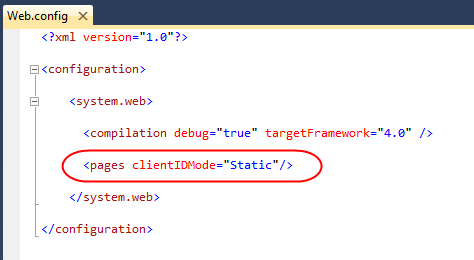
Example: using the ClientIdMode property for non-list controls
Let's take a look at how you can use the new ClientIdMode property for controls on the page by setting “ID”. For demonstration, we will create a simple page, call it “SingleControlExample.aspx”, which is based on the master-page “Site.Master”, and contains one element


Generate markup when ClientIdModel is set to “Predictable”
With ASP.NET 4, server-side controls are generated by default using ClientIdMode = ”Predictable”. This allows you to be sure that all ID values are unique and that there are no conflicts on the page, while the ID is less verbose and more predictable. This means that the generated control layout
Generate markup when ClientIdModel is set to “Static”
Sometimes you don’t want the ID values not to be hierarchical, but just go with the value we want to set: All this gives us the opportunity to fully control the value of the client ID of the controls.
Example: using the ClientIdMode property for lists associated with data
Lists or grids associated with data have historically been difficult to use or customize styles when working with automatically generated IDs in Web Forms. Now let's take a look at the scenario where we will configure the ID for the ListView in ASP.NET 4.
The following is a snippet of ListView code that displays the contents of a linked collection, in our case airports: Next, we can write the code in a code-behind file to dynamically link the list airports with ListView: At runtime, the default list will look like
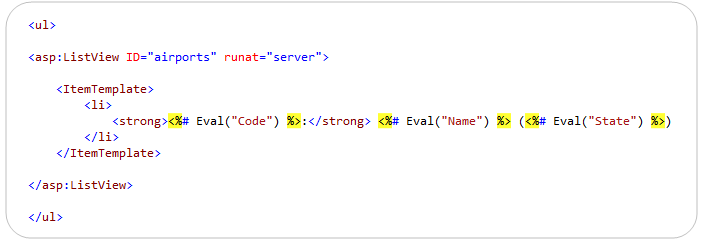

- . Note that
- the items in the ListView are not server controls, and for them there is no ID in the markup:
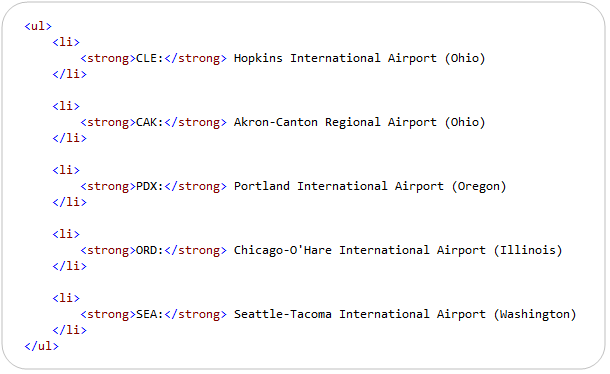
Add a client ID for each line
Let's imagine that we need to add a client ID, for programmatic access to each - , via JavaScript. We want the ID data to be unique, predictable and recognizable.
Need to tag each - in the template as a server control by setting the runat = ”server” attribute and giving each id “airport”:
By default, ASP.NET 4 will generate a clean ID, as shown below, there will be no ctl001:
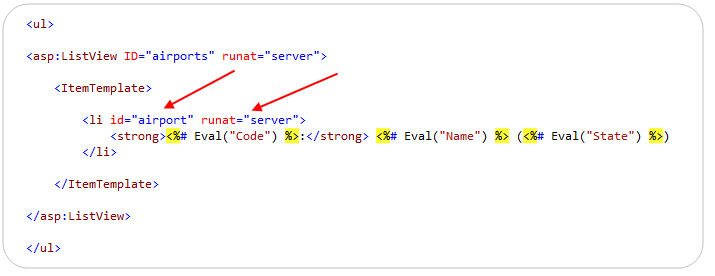
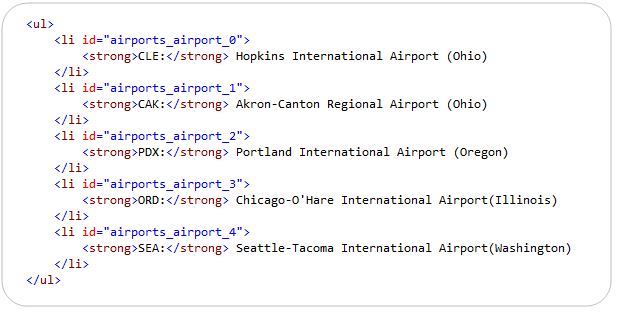
We use property ClientIDRowSuffix
Our above template now generates unique IDs for each - element, but if we programmatically access it through JavaScript, we would like the ID to contain the airport code. The good news is that you can do this very simply using the new ClientIDRowSuffix property in the associated ASP.NET 4 control:
To do this, set the ClientIDRowSuffix property to “Code” in our ListView. It tells ListView to use the associated “Code” property from our Airport class when generating the ID: Now, instead of the suffix “1” or “2”, we get the value Airport.Code (_CLE, _CAK, _PDX): You can use ClientIDRowSuffix in any other elements that have a data connection, such as a GridView.

Summary
ASP.NET allows you to generate much cleaner HTML markup for server controls.
In the next article, I will talk about other innovations that affected markup in ASP.NET 4.
- and
